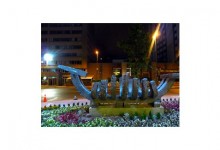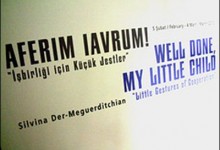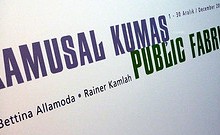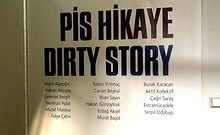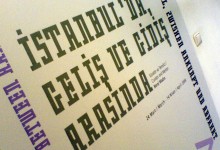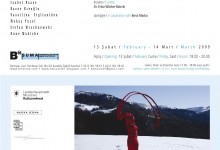ONCE UPON A TIME…
PABLO MARTINEZ MUNIZ POHOTOGRAPHY EXHIBITION
8 JANUARY-7 FEBRUARY 2009
Catalogue Text:
COUPLED DILEMMAS
BM SUMA CONTEMPORARY ART CENTER is organizing the third exhibition on images of Istanbul with the photography of the Spanish artist Pablo Martinez Muñiz, who has been living here since 2003. Martinez is going to expose his photos entitled as: Kurban; Fragmentpolis; Unfinished Buildings; Silence I: The Caravans Road; Silence II: In the Desert; The Memories of the Infinite Defeat, When the Flag Becomes an Obsession; Iran_Nari; Istanbul, a City of Love and Dreams! and Exiles: In Honour of Yılmaz Güney in a particular installation conceived by him, in 10 rooms of the center. How does an artist who has lived neither his infancy nor his youth in this country or in this city can express his interpretations? This is a question to be raised as it indicates that the memory in question is not covering a long period of time. It is not easy to re-read and interpret the transformations which are even enormous for the people who have been born and grown in this country or this city and how they fit into a lifetime is hardly understandable. The destructive results of globalism in this country and city are undeniable when all the scientific investigations and analyses are classifying and revealing the results of this destruction. However, at the same time there is a positive face of globalism that many foreigners from different countries, especially the creative ones, are coming here to live and work. No doubt there are socio-political, economical and cultural reasons behind this venture. For example, especially for the people from European Union, Istanbul is a field of entry into Turkey which is for them the source of the dilemma of “being accepted / not accepted “. At the same time Istanbul is the only acknowledged part of “the not accepted” Turkey… For the creative people however, Istanbul is a field of fertile chaos that supports the bed of imagination with its transformations, contradictions, complicated urban texture and un-urbanized population as well as with its particular pairings of tradition/arabesque and modern/kitsch. After coming in, these guests want to see more in and beyond Istanbul. One of the most attractive adventures of our era is to discover this country or this city that transforms itself continuously. It is the adventure of observing and understanding the particular intimidating disorder of a city or a country, of the side by side existence of limitless affluence and deep poverty and of the unanimity of overpowering masses and frightening desolations. Pablo Martinez Muñiz has particular motives to wish to live in Istanbul. Just as he says, here he leaves his orientalist prejudices behind and finds a rich material to think and talk about topics such as seclusion, lack of communication, power, existence, and religion and in particular vitality that is not so visible. Nevertheless, the visual production he is presenting to us is positioning him into the above mentioned evaluation. He is also living an adventure; while he is living it, he documents the subjects and when he is documenting, he is revealing himself and he is transforming them. Like the others, his visual material is the archaeology of the architecture and people of the city. Here we have to focus on the question of which photographs are “documentary” and which have the quality of “artwork”. We have to mention two elements, the constructive one and the attractive one of the photography: The general effect of the image is based on the observation and is informative; the conceptual effect cuts through this general effect, strikes and wounds the viewer. The detail that is concealed on the surface of the photo and in all probability that holds the coincidental moment of shooting can destroy the order of seeing. The viewer is hit. The difference between the documentary photograph
and a photograph as an art work is in evidence, when we feel the necessity of making this difference. In Martinez Muñiz’s photographs we can perceive that this general knowledge and the striking detail are shown side by side. In particular the series of double photographs entitled “The memories of the Infinite Defeat” playfully provoke the perceptive skills of the viewer. The informative overview couples with a coincidental moment and positions the photography beyond the documentary. When I asked to Pablo Martinez Muñiz “What is your intention in placing the photographs side by side?” he replied that he wants to assemble a narration which is emanating from the tension of complementation and contradiction. The coupled photographs Yılmaz Güney and the unfortunate children in the parks; Anatolia’s ways and Tunisia’s deserts; the desolate suburbs and the graffiti reflect impressive narrations. In Martinez Muñiz ‘s photos we can read his deluge between two adventures of conquering Istanbul and Turkey: a critical gaze to the political, economical and cultural problems of Turkey, and a gaze that reflects an considerate approach of penetrating into the basic geographical and cultural problems of the people, without exploiting them.
Beral Madra, December, 2008
Katalog metni:
İKİLEMLİ EŞLEŞMELER
BM Suma Çağdaş Sanat Merkezi, İstanbul üstüne kurgulanan sergilerinin üçüncüsünü 2003’den bu yana İstanbul’da yaşayan İspanyol sanatçı Pablo Martinez Muniz’in fotoğraf işleriyle gerçekleştiriyor. Martinez Kurban; Sürgünler: Yılmaz Güney’in Anısına; Fragmentpolis; Bitmemiş Binalar; Sessizlik: Kervan Yolu ve Çölde; Edebi Yıkımın Hatıraları; Bayrak Saplantıya Dönüştüğünde; İran_Nari; ve Kent Bir Aşktır, Kent Bir Rüyadır… o İstanbul’dur! başlıklı fotoğraflarını merkezin 10 odasında özel olarak tasarladığı bir düzende sergiliyor. Çocukluğu ve gençliğini bu ülkede ve kentte geçirmemiş bir sanatçı nasıl bir yorum yapar? Bu bir anlamda uzun bir zaman dilimini içeren bir belleğin olmadığını işaret ettiği için sorulması gereken bir soru. Bu ülkede ve kentte doğmuş, büyümüş ve yaşıyor olanlar açısından bakıldığında, bir insanın yaşamının içine bunca değişim nasıl sığar dedirten değişimleri yeniden okumak ve yorumlamak o denli kolay bir iş değil. Küreselleşmenin bu ülkedeki ve kentteki tahribatını görmezden gelemeyiz; bütün bilim dallarındaki araştırmalar ve saptamalar bu yıkımları istifleyerek, sınıflandırarak önümüze koyuyor. Ancak küreselleşmenin olumlu görüngülerinden birisi de, farklı ülkelerden insanların, özellikle de yaratıcı insanların, gelip burada yaşamak ve burada üretmek istemeleri. Bu isteğin temelinde siyasal, ekonomik, kültürel nedenler var, kuşkusuz. Özellikle AB insanları için İstanbul “istenen/istenmeyen” ikilemini oluşturan Türkiye’ye bir giriş coğrafyası. İstanbul aynı zamanda “istenmeyen” Türkiye’nin “kabul edilebilir” tek parçası… Yaratıcı insanlar için İstanbul, söz konusu değişimleri, karşıtlıkları, dolambaçlı kent dokusu, kentleşmemiş insan dokusu ve kuşkusuz geleneksel/arabesk, modern/kitsch eşleşmesiyle yaratıcılığın düş yatağını oluşturan verimli bir karmaşa alanı. İstanbul’a girdikten sonra da daha ötesini görmek istiyor bu konuklar… Sürekli değişen bir ülkeyi ve kenti keşfe çıkmak, günümüzün en çekici serüvenidir. Başka bir ülkenin, başka bir kentin kendine özgü yıldırıcı düzensizliğini, sınırsız zenginliklerle derin yoksullukların yan yana varoluşunu, bunaltıcı kalabalıklarla ürkütücü ıssızlıkların kardeşliğini izlemek ve anlamak serüvenidir bu. Pablo Martinez Muniz’in özel nedenleri vardır, İstanbul’da yaşamak istemesi açısından. Nitekim İstanbul’da ve Türkiye’de yaşarken oryantalist önyargılarından sıyrıldığını, yalnızlık, iletişimsizlik, iktidar, varoluş, din ve görünmeyen bir özellik olarak da canlılık gibi konular üstünde düşünmek ve konuşmak için zengin bir malzeme bulduğunu söylüyor. Ancak, bize sunduğu görsel üretim onu ister istemez yukarıda sözü edilen genel değerlendirme içine çekiyor. O da bir serüveni yaşamaktadır; yaşarken belgelemekte, belgelerken kendini anlatmakta, anlatırken dönüştürmektedir. Kentin mimari ve insan dokusunun arkeolojisini yapmak, herkes gibi onun da yapıtlarının görsel malzemesini oluşturuyor. Burada, hangi fotoğrafların “belgesel” hangilerinin “sanat yapıtı” niteliği taşıdığı üstüne odaklanmalıyız. Fotoğrafın yapısını kuran ve ilgi uyandıran iki öğesinden söz etmemiz gerekir: Gözleme dayanan görüntünün genel etkisi ve bu genel etkiyi delip geçen, izleyiciye çarpan ve onu yaralayan kavramsal etki . Fotoğrafın yüzeyinde gizli olan ve belki de çekildiği anın rastlantısallığını içeren ayrıntı, görme düzenini altüst edebilir: İzleyici isabet almıştır. Fotoğrafın belgesel olması ve sanat yapıtı olması arasındaki ayrım, biz o ayrımı aramak gereğini duyduğumuzda belirginleşir. Martinez Muniz’in fotoğraflarında bu genel bilgi ile vurucu ayrıntının yan yana gösterildiğini izliyoruz. Özellikle “Sonsuz Yenilginin Anıları” başlıklı dizideki ikili resimleri izleyenin algı süreci üstünde bu oyunu oynuyor. Her genel bilgi bir rastlantı anıyla eşleşip, fotoğrafı belge olmaktan öteye geçiriyor. Martinez Muniz’e “Fotografları yan yana yerleştirerek neyi amaçlıyorsunuz?” sorusunu sorduğumda karşıtlık ve bütünlük arasındaki gerilimden çıkan anlatıyı kurgulamak istediğini, söyledi. Etkileyici anlatılar Yılmaz Güney ve sokaklardaki ve parklardaki yoksul çocuklar; Anadolu yolları ile Tunus çölleri; kentin varoş manzaraları ile duvar yazıları eşleşmelerinde izleniyor. Martinez’in fotoğraflarında, onun Türkiye ve İstanbul’u keşfetme serüveninde iki bakış ve yorum arasında gidip geldiğini okuyabiliriz: Türkiye’nin siyasal-ekonomik-kültürel sorunlarına eleştirel bir bakış ve insanları göstermeden onların temel coğrafi ve kültürel sorunlarına anlayışla nüfuz etmek isteyen bir yaklaşımı içeren bakış…
Beral Madra, Aralık 2008

